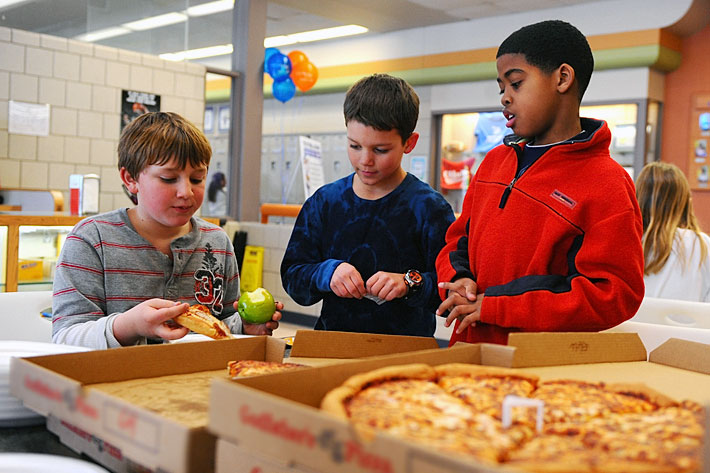Children’s health experts have repeatedly warned Americans about the dangers of Big Macs, french fries and chicken nuggets. Many fast-food restaurants have responded to criticism by removing soda options and adding fruit to children’s meal menus.
Less talked about is the extent that pizza—one of America’s most popular foods—contributes to poor diets in children and teenagers.
Pizza consumption is associated with many of the same negative effects of fast food, including excess calories and increased sodium intake, and could be tipping youth toward obesity, says a new study co-authored by George Washington University researcher Bill Dietz.
The study, published Monday in the medical journal Pediatrics, shows that one out of five U.S. children and nearly a quarter of adolescents consume pizza on any given day. The researchers found that a child consumes an extra 84 calories, 3 grams of saturated fat and 134 milligrams of sodium on days he or she eats pizza. For teenagers, it’s an excess 230 calories, 5 grams of saturated fat and 484 milligrams of sodium.
These numbers mirror results from previous studies on fast-food consumption.
“What’s not to like about pizza?” said Dr. Dietz, director of GW’s Sumner M. Redstone Global Center for Prevention and Wellness in the Milken Institute School of Public Health. “But rather than being an everyday food, I think people need to recognize that this is a significant source of calories.”
A “New Stage” in the Obesity Epidemic
The researchers analyzed 24-hour dietary recall data from participants in the National Health and Nutrition Examination Survey from 2003 to 2010.
Previous studies have shown that pizza consumption is the second highest source of daily caloric intake among 2 year olds to 18 year olds, surpassed only by “grain desserts,” like cookies and cake. Dr. Dietz and his colleagues were interested to find out how much the food contributes to excess caloric intake, as well as whether the impact of eating pizza differs by gender, race/ethnicity and income.
Dr. Dietz found the frequency of pizza consumption particularly disturbing. He said he was surprised that children and teens did not compensate for their unhealthy choices on days they ate pizza.
In 2009 to 2010, pizza comprised 5 percent and 7 percent of children’s and adolescents’ total daily calories, respectively. On days when pizza is eaten, it represents 22 percent of children’s total calories and 26 percent of teens’ calories.
The researchers found that when pizza is eaten as a snack (rather than a meal for lunch or dinner), it had the greatest adverse impact on total energy intake for both children and adolescents.
These results are more or less consistent across the board. The researchers’ data reflects no significant changes in pizza-eating habits for any of the subgroups they tested.
Despite the high numbers, the study’s data shows some positive changes in pizza-eating habits. From the first survey in 2003-2004 to the last survey in 2009-2010, calories consumed from pizza declined by 25 percent among children. Daily average calories from pizza also declined among teens, but more teens reported eating pizza in this time period.
Dr. Dietz said that while the positive trends are encouraging, the numbers suggest that pizza remains a significant contributor to the childhood obesity epidemic.
In 2012, more than one third of children and adolescents were overweight or had obesity according to the Centers for Disease Control and Prevention, putting them at risk for long-term health problems like heart disease, type 2 diabetes and stroke.
“We’re at a new stage with the obesity epidemic,” Dr. Dietz said. “There have been recent declines in the prevalence of obesity among 2 to 5 year olds and plateaus in obesity among children and teenagers.”
He noted that, according to one previous study, the decrease in daily calories needed to return the mean Body Mass Index (BMI) to a healthy total by year 2020 is around 150 calories per day for U.S. children age 6 to 11 and around 180 calories per day for teenagers.
Excess calories contributed by pizza consumption could contribute to the difference between a healthy and an unhealthy teen.
“These apparently modest declines in pizza consumption could be significant contributors to the fact that we’re seeing changes in the prevalence of obesity in the youngest children—because the caloric deficit is the smallest there—and why we’re seeing plateaus in older children and teenagers,” he said. “Our data suggests that changes in pizza consumption can have a positive impact.”
Dr. Dietz said he’s not suggesting a ban on pizza. He likes the cheesy pie as much as the next person. Instead, he recommends that children and teenagers watch their portion sizes (sorry, Jumbo Slice), limit their pizza consumption and choose healthier options, such as slices made with whole wheat dough or vegetables, rather than meat.



